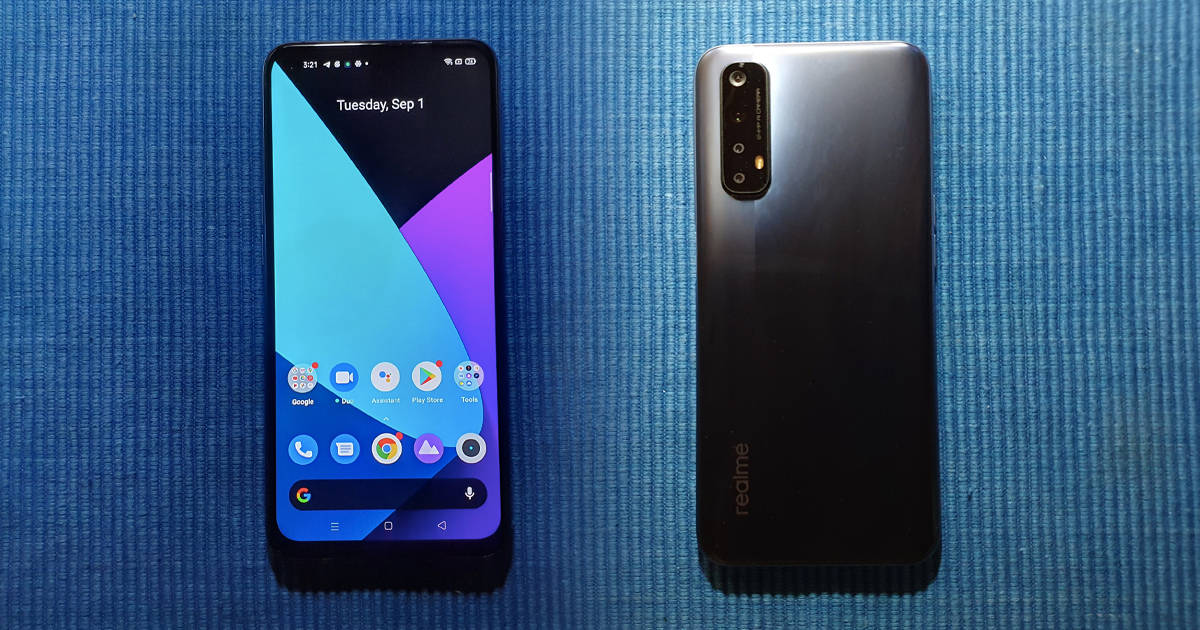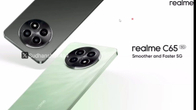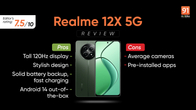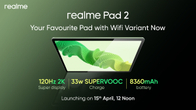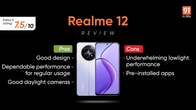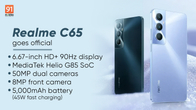Review Summary
Expert Rating
A year back, your typical budget smartphone would be a concoction of a lasting battery, above-average display, a chipset just good enough to push through medium tasks and a set of decent cameras. It is fair to say that the intense competition between Chinese smartphone giants Realme and Xiaomi, in India’s most voluminous smartphone segment, has pushed the limits of budget devices. Now features like high screen refresh rate screen, quad cameras with 64MP primary sensors and super-fast charging solutions are becoming the new norm, even in the affordable segment. I was more than impressed with the Realme 6 series and in particular how graphically adept the Realme 6 (review) was. It appears that performance has again taken centre stage for the successor of the device, the Realme 7 which has been announced starting at Rs 14,999.
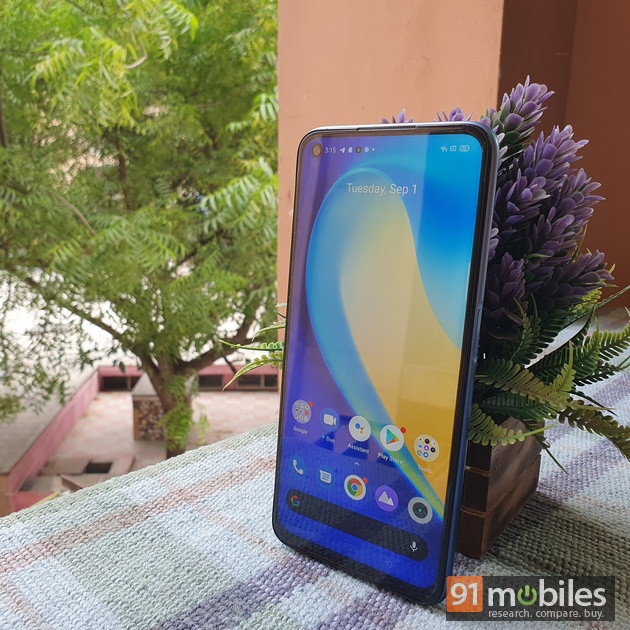
Externally, Realme has changed very little on its latest budget smartphone, doubling down on its philosophy of ‘if it ain’t broke, don’t fix it’. This is something that the company has been known to do on a number of successive smartphones. Internally, the Realme 7 now boasts of the latest MediaTek G95 SoC which is the first time we are seeing it. It has been very impressive how in a very short period of time the benchmark for judging smartphones has risen. It seems only a matter of time before the upcoming Redmi Note 10 series challenges Realme on all fronts and I’m sure that it will be an interesting battle of specs. For now, let’s dive into my review of the Realme 7 and see if the company has improved upon the Realme 6 experience.
Verdict
The Realme 7 is just a Realme 6 with the right amount of upgrades. Whether it is in the camera or the performance or battery, the Realme 7 hits all the right spots for a compelling affordable phone experience.
Design and display
- Display: 6.5-inch FHD+
- Refresh rate: 90Hz
- Panel: IPS LCD
- Connectivity: USB Type-C
These days it is hard to constitute what a premium feel for a device really is. Many, myself included, lean towards a polished back with tapered edges, a curved frame and a matte finish. The fact that these options can be offered on a phone under the Rs 15,000 price point is frankly astounding and pleasing at the same time. Visually, the Realme 7 shares a lot of design elements that the company has been carrying over for the past couple of generations of the device. The staple is the polycarbonate unibody material, vertical quad-camera array, and the Realme branding on the bottom right.

Apart from that, there are design aspects ported over from the Realme 6, such as the side-mounted fingerprint sensor which also functions as a power button and the punch-hole on the front of the device. What is different is the new colour scheme adopted by Realme called the AG Split Design wherein you get two gradient tones of the same colour on either side of a line running from the camera bump to the bottom. I have received the Mist Blue variant for reviewing and from the feel of it, it does appear to have a matte finish. It shines exquisitely in sunlight but still attracts a lot of smudges. So I recommend the clear silicone case that Realme so graciously provides inside the retail box.

In terms of ports, you will be getting the standard deal in the form of a 3.5mm headphone jack, Type-C, and a speaker grille at the bottom. The right side of the device has the power button which doubles as the fingerprint sensor while on the left are the volume rocker buttons along with the dual-SIM + microSD card slot. The Realme 7 does not feel heavy and the sides are precision curved to sit comfortably on my palm. It is the kind of build quality that has become standard in the affordable segment and benefits the users too.
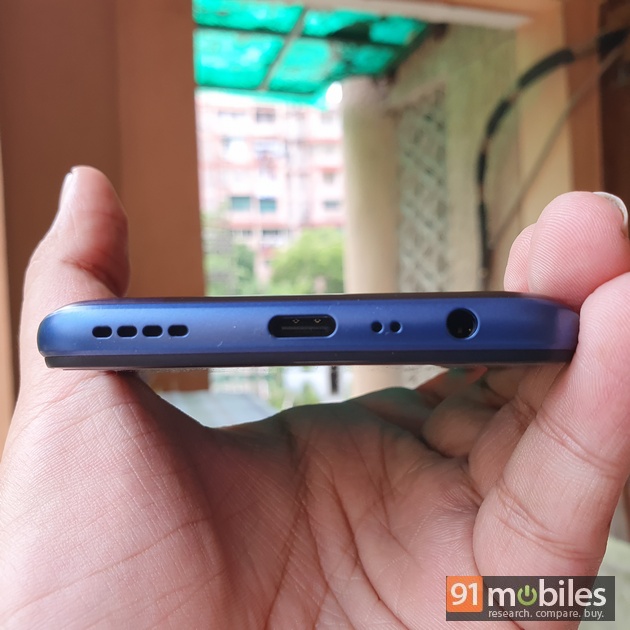
Realme also has claimed that the Realme 7 is the first phone to get the TUV Rheinland Smartphone Reliability Verification. This gives the device more reliability during day-to-day usage although this verification is not something that the end user will think about when purchasing the device.
As far as the display goes, you are getting more or less the same deal as the Realme 6. This includes the 90Hz high refresh rate panel which has found its way from flagship to affordable phones in a short space of time. The punch hole for the selfie shooter finds its way to the top left and is the same size as it was in the Realme 6. In terms of the display, the Realme 7 offers a 6.5-inch IPS LCD panel with a 20:9 aspect ratio, FHD+ (2,400 x 1,080) resolution and a claimed 90.5 percent screen-to-body ratio. All these specs combined with minuscule bezels make for something of a viewing spectacle in the budget segment. The feeling is echoed in my colleague’s Realme 6 review as well.

Colours are slightly saturated and the blacks are not as profound as on an OLED panel but the brightness levels and the lack of colour shift when viewed at a steep angle, will leave you impressed. Inside the device are customisation options such as to toggle the refresh rate and OSIE which is a feature that is said to improve colours while viewing a video. Personally I saw very little difference with the feature turned on. Standard settings to customise the colour temperatures and a blue light filter to reduce strain on the eyes while reading at night are present as well. Widevine L1 certification on the device means that you can enjoy Netflix and Amazon Prime in HD quality.
Cameras
- Rear cameras: 64MP primary, 8MP ultra-wide, 2MP macro sensor and 2MP mono sensor
- Front cameras: 16MP
The 64MP Samsung Bright GW1 sensor seen on the Realme 6 has been ditched in favour of the Sony IMX682 sensor which is the flag bearer of Realme 7’s quad-camera array. Apart from that, the other sensors remain the same, namely an 8MP ultra-wide lens, a 2MP macro sensor and a 2MP mono lens which the company is calling as ‘B&W Portrait lens’. So it is clear, that the main debate between the Realme 6 and Realme 7 will be settled by the one whose primary lens takes better shots. The answer is the Realme 7, but not by a large margin.

If we are to go by colour reproduction and dynamic range, I can say that both the Sony and Samsung sensors are up to the mark. The Realme 7 takes some of the crispest and most colour accurate shots the affordable segment has to offer. Fine details are visibly clear rather than being smoothened over and saturation levels are kept under control to a certain degree. The Chromaboost feature pumps up saturation levels quite a bit, making for social media-worthy photos. The familiar quad-pixel technology is present to take a full 64MP shot which gets in substantially more details, but it will not work very well for moving objects.

However, on the subject of night photography, the Sony IMX sensor on the Realme 7 is ahead of the Realme 6’s Samsung GW1. What the former does better is get a good amount of exposure inside a low-lit shot and keeps the noise to a minimum while the latter is sub-par in both those aspects. The dedicated Night mode also makes for a good visual difference in terms of colours and better shadows. Realme 7 is one of the better night time cameras I have seen in this segment.
There are other cameras on the Realme 7 but they are your standard run of the mill sensors which offer an unchanged experience from the Realme 6. The 8MP wide-angle camera will work as expected in bright sunny conditions but falters in the night. The macro camera has a 4cm focal length which is fixed but shots vary greatly in terms of colours and the mono lens doesn’t find a lot of use cases unless you like to click monochrome portrait shots.

On the front is a 16MP selfie shooter that is the exact same sensor which is present on the Realme 6. Selfies were up to the mark with colour tones in the acceptable category and details slightly oversharpened. At night the front camera makes uses of the Night Mode for more exposure and detailing.
Performance and software
- Chipset: MediaTek G95
- RAM: 6GB and 8GB LPDDR4
- Storage: 64GB and 128GB, expandable to 256GB
- Software: Android 10 with Realme UI
The new MediaTek G95 chipset has been introduced on the Realme 7 and it is being touted as a gaming processor. While no affordable phone is going to match flagship devices in terms of serious gaming, the Realme 7 does come astonishingly close. In PUBG Mobile (which has been banned now), the Realme 7 fares pretty well for a phone of its price point. The graphic options are set at a maximum of HD while the frame rate option is capable of going till Ultra. For comparison, the Ultra frame rate is also the highest you can go if you are on a Snapdragon 700 series or below. To see the G95 chipset go toe-to-toe with something like the Snapdragon 765G on the much more expensive OnePlus Nord (review) is surprising, to say the least. Much of the playing experience is largely lag free for about 1 – 1.5 hours, after which the device does start heating up. The 90Hz display will not be of any use during PUBG Mobile as the game currently does not support a high refresh rate on any phone other than OnePlus flagships.

As a phone for daily usage, the Realme 7 works just as well as any upper mid-range device or even a budget flagship. Running benchmarks on the device showed scores of 514 and 1,665 on single-core and multi-core respectively on Geekbench 5. On AnTuTu the overall score happened to be 290,207 which is near about the same as the Realme 6. As a daily driver, users on a budget will have no problems in navigating through multiple apps or Chrome tabs while simultaneously running downloads in the background or switching directly to a YouTube video. Scrolling through apps such as Facebook and Instagram was a breeze. The 90Hz display helps making all these actions seem smooth. I have the received the 8GB RAM + 128GB storage variant which is a great combination, but Realme also offers a 6GB version with 64GB storage that can be expanded to 256GB using a microSD card. Overall the average user will be more than happy with the performance and usability of the Realme 7. A special shoutout to the lightning-fast fingerprint sensor on the device but the face unlock method still needs a little fine tuning. Call, microphone and speaker quality were up to the mark for a sub Rs 15,000 phone.

Realme has been using its customised version of Android called Realme UI on all of its recent phones and the same is true for the Realme 7. It is a software skin based on Android 10 and resembles OPPO’s ColorOS UI. Our reviews of previous Realme phones have explained in detail about how Realme UI experience is and you can read it here. In short: clean interface, redesigned app icons, enhanced dark mode, a good amount of bloatware and nice animations. Realme has also added a couple of experimental features under the ‘realme lab’ settings tab which it says are currently in beta and will be updated from time to time. These include Dual Mode Audio, which enables you to play music through a pair of wired earphones and Bluetooth earphones simultaneously, Smooth Scrolling and Super nighttime standby which basically optomises your phone to consume less battery at night.

Battery
- Capacity: 5,000mAh
- Charging speeds: 30W Dart Charge
- 0-50 percent: 27 minutes
Realme has upgraded its battery capacity from 4,300mAh to 5,000mAh and it has really made a lot of difference. For starters, PCMark’s Work 2.0 test for the battery life yielded a time of 9hr 50min at 60Hz on the Realme 6. The Realme 7 had a time of 13hr 4min for the same settings which is an increase of more than 3 hours. On top of that, the device retains the superfast 30W Dart Charge which will juice up the battery from 0-50 percent in a mere 27 minutes. A full charge is done in an hour which is about the same time as the Realme 6, but do keep in mind that the latter has a smaller battery. In terms of real-world usage, the phone is very easily a one-day device and the usage off a single charge can be pushed to nearly a day and a half if the refresh rate is kept at 60Hz.
Final Verdict

Realme has been delivering on a quality smartphone experience since its existence as a sub-brand of OPPO, and even now when it has become a separate entity from its parent company. Yes, the prices of Realme phones have been steadily increasing which blur the lines between a budget and mid-range smartphone. However, it is a testament to Realme’s consistency in offering VFM devices that the brand has become one to reckon with in a short period of time. After having used for about a week, I can safely say that the Realme 7 is currently among the best phones under Rs 15,000. At least until Xiaomi is ready to fire the next salvo in this space.
Editor’s rating: 4 / 5
Pros
- Capable 90Hz display
- Smooth performance
- Good battery life
- Fast fingerprint authentication
Cons
- Mono sensor isn’t very useful
- Comes with bloatware
 | Rs. 14,490.00 | Go To Store |

